

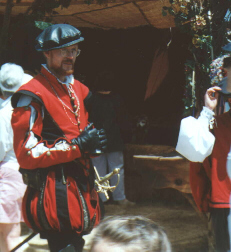 |
Here you see a very good example of a fine costume. The doublet with removable sleeves, the pumpkin breeches, which I call slops, worn over tights, with thigh high boots. The understated yet elegant leather flat cap makes a fine accessory. When you look at it, you can see how easy it would be to make your own. I can't help you with the sword, though. |
| Fierce warriors from the East joined our Faire Folk this day. Notice the Chakram (throwing ring) the warrior princess is carrying on her belt. The Chakram came from eastern lands, and can still be seen in use today. I must say, though, that the day was HOT when we traveled to the Faire, and I can imagine the helmets were open more often than closed. I envied the princess her shade, the conical hat attached to a rod that ran down her back and fastened to her belt. Some people think that ethnic costumes like these, or Samurai garb, are not period. But we must remember that many of the romantic eras we see in movies ran concurrently. Feudal Nippon was going strong during the English Renaissance. Well traveled merchants or sailors might have stolen a katana to add to a rapier or boarding sword. |  |
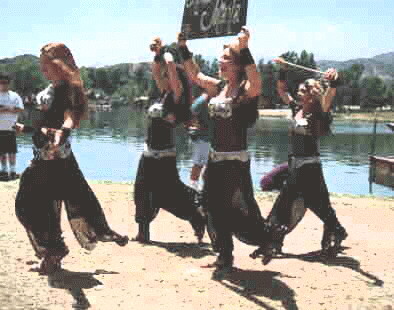 |
And I'm very GLAD of the ethnic variety possible. These young ladies'
sparkling raiment is made of coins chained together. One could say it's
"pricey garb." (sorry :-)) They are advertising an Arabian Dance show that's
a Faire favorite. I would say it's belly dancing, but there's much more
to the show than just that. |
| Two participants practice a duel routine for one of the pageants that are produced at the Faire. Notice how the sleeves are unbuttoned on one's costume. You now see the reason for that feature. Also, notice the strong contrast of colors in his opponent's doublet: an ivory yoke and black body. Very stylish! |  |
 |
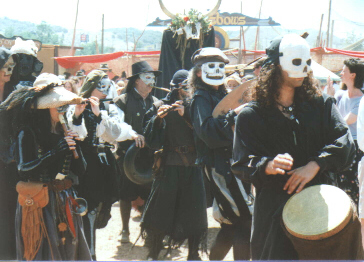 |
| The Dance Macabre! A parade through the Faire that celebrates the "defeat" of the Black Plague. Merchants at the Faire will sometimes have someone put on a death mask and dance in front of their booths when the parade goes by, hence seeming to be dead as the sign suggests. The plague then cannot harm them. To the rest of us though, the masquerade will sneak up on you and you'll feel the mocking touch of "death." | |
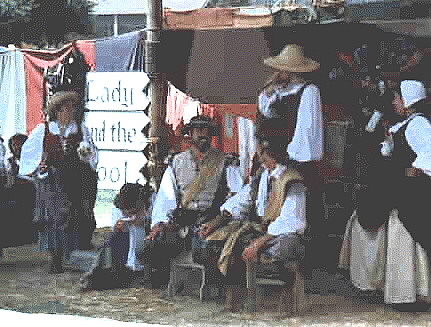 |
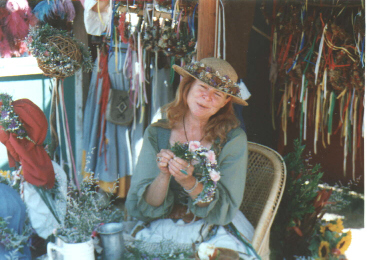 |
| Various local personalities trade gossip with the washer women, "washer" being pronounced with a short "a", at the town well. And a pleasant spirited lady weaves and sells garlands of ribbons and dried flowers from her booth, singing as she goes. I caught her mid-verse. Now, this photo should give you and idea how to decorate even a plain, store-bought straw hat into an proper RenFaire costume element. | |
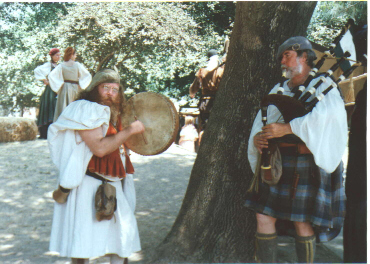 |
 |
| Celts are a very visible part of the Faire, with a wonderful camp where they show off their crafts and weapons. Here are three outstanding examples of period dress for those who like their clothes a bit breezy. I've worn a kilt in years past, and they are COMFORTABLE on a hot day! Pay special attention to the jerkin worn by the Scottsman playing the bodhran. He's wearing truly traditional celtic garb, a Leine, which is a linen shirt, with pleated sleeves, that falls to the ankles, then is drawn up around the knees. The short jerkin he sports is an ionar, and were the common item worn over a leine. Originally, leines were dyed saffron yellow, but, frankly, the spice saffron was never really used as a dye, as it was FAR to expensive to waste in such a way. Some have argued that the plant dye was derived from the safflower, which produces a slightly greenish yellow. Most likely, "saffron" was meant to convey ANY golden, spicy yellow, regardless of how it was derived. However, as persecution of Scotts by Sassenach lords increased, the very color "saffron" was outlawed for use in celtic garb. So by the Renaissance, leines were left natural. The great kilt worn by our other friend was a relatively new addition to celtic wardrobe during the Renaissance, itself was also outlawed for a while. As others have noted, the movie, "Braveheart," had this point wrong. | |